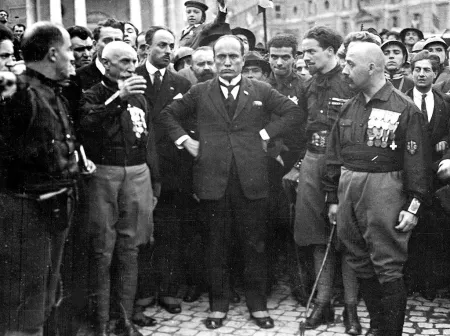(Pasquino relives the March on Rome.)
Halloween is becoming more popular in Italy than Carnival, thanks to American TV. Teenaged zombies startle tourists in piazzas and frighten seniors in alleys. These pranks are harmless enough, but the spectacle reminds me of a more sinister masquerade: Benito Mussolini’s March on Rome.
October, 1922 was one long Witches’ Sabbath. Then as now, young ghouls overran Italy. After a general strike had touched off riots, thousands of students joined the squadristi: the paramilitary squads of the rising Fascist Party. Called the Voluntary Militia for National Security, these boy vigilantes ruled the streets.
Waving banners with the skull and crossbones, the squadristi wore black shirts and military insignias and carried pistols, rifles, and grenades. The guns rarely were loaded, though, and the grenades almost always were duds. Instead, daggers, truncheons, and clubs intimidated and injured opponents. On Fridays, more devout hooligans beat their victims around the head with baccalà.
Nobody could control the squadristi, not even Mussolini, who watched events unfold in Milan. Safe in his headquarters, he wrote incendiary articles, abused bespectacled parliamentarians, challenged enemies to duels, and forecast a national bloodbath, but he never once participated in a street brawl. Even as he egged on followers to march on Rome, Mussolini negotiated with officials and planned his escape to Zurich.
This waffling exasperated his second-in-command. “We’re going,” Italo Balbo declared on Tuesday evening, October 24, “either with you or without you! Make up your mind!” Mussolini pursed his lips, jutted his chin, and folded his arms across his chest. He was resolved. He would remain behind in Milan, a short drive to the Swiss border, while his henchmen slogged to the capital through heavy rain.
The marchers, some 26,000 men, seized telephone exchanges, telegraph offices, town halls, and prefectures in Tuscany and Emilia-Romagna. Only 16,000 reached Rome. Lacking food and ammunition, this sodden and demoralized crew was no match against the army. Nevertheless, Victor Emmanuel III refused to declare martial law. The king detested the Fascists but dreaded the Communists, who wished to abolish the monarchy. He also dreaded his mother, Margherita of Savoy. Occupying the state room like an overstuffed divan, the dowager queen called Mussolini “the greatest condottiero since Bartolomeo Colleoni.”
On Sunday morning, October 29, the king bowed to political and domestic pressure. He telegrammed Mussolini and asked him to form a new cabinet. Prime Minister Luigi Facta had resigned. Recording the event in his calendar, the king wrote: “I order Mussolini.” As if the Duce was nothing more than a pizza.
The pie arrived the next day, with all the toppings. Mussolini had intended to travel by plane and scatter leaflets and confetti in his wake. Much to his chagrin, he could not even catch an early train. This humiliation strengthened his resolve to make the railroads run on time. Obliged to depart on a luxury sleeper, Mussolini compared the comfy nine-hour ride to Caesar’s crossing the Rubicon.
At the stroke of eleven, Italy’s new prime minister presented himself to the king in a shabby morning coat, borrowed spats, and a Fascist black shirt. “Please excuse my appearance, Your Majesty” he said, “but I have just returned from the battle which we had to fight. Fortunately, without shedding blood.”
Mussolini declared allegiance to the House of Savoy, swore to protect the Albertine Statute, and promised to restore “the Italy of Vittorio Veneto.” Like a seasoned courtier, he bowed, clicked his heels, and left. His shoes squeaked on the parquet floor. Visibly relieved, the king turned to his palace crony, Vittorio Solaro del Borgo. “The nightmare is over,” he said.
Few realized that it had only begun. Blame the regalia. Mussolini’s black shirts, party ministers explained, were modeled after machinists’ uniforms, just as Garibaldi’s red shirts had been glorified butchers’ smocks. Historians scoffed at the analogy, but Garibaldi’s grandsons, Ezio and Peppino, supported the new regime. Didn’t their nonno also march on Rome? Didn’t his followers also beg him to seize power?
Du-ce! Du-ce! Du-ce!
The Fascists held a victory parade. Fifty thousand marched before the Altar of the Fatherland, singing “Giovinezza” but also Risorgimento hymns. Bands blared and orators spieled in Piazza Navona. Propaganda films were shown. When garibaldini and squadristi exchanged Roman salutes on screen, the mob cheered.
From red shirts to black shirts in sixty years, I mused. History is a tawdry costume shop.
Trick or treat!

